 [The Planning Board of the Town of Marbletown, NY, our local government, has put forward in all seriousness a proposal to site a county-wide methadone clinic in our sleepy little rural community. Putting a finer point it, the proposal, if accepted, would place that facility directly across from our house, just 200 feet away, in full view of our home, yard, carport, and car. I’m making my opposition to this project clear.
[The Planning Board of the Town of Marbletown, NY, our local government, has put forward in all seriousness a proposal to site a county-wide methadone clinic in our sleepy little rural community. Putting a finer point it, the proposal, if accepted, would place that facility directly across from our house, just 200 feet away, in full view of our home, yard, carport, and car. I’m making my opposition to this project clear.
Have I reached my NIMBY moment? I don’t think so. Back in the 1980s, when I lived in the Stapleton neighborhood of Staten Island’s North Shore, I actually spoke in favor of siting a methadone clinic not far from my house. I did so because, at the time, drugs — crack especially — and resulting crime ravaged this community.
So I see a logic, and also an ethic, to situating substance-abuse treatment centers right where the problem manifests itself. By the same token, I see neither logic nor ethic to locating such a facility in a quiet rural community that does not have a significant level of drug trafficking or a verified triple-digit number of addicted residents in need of treatment.
In response to this situation, I wrote a sober, detailed letter to the Planning Board in opposition to this project. And I wrote a shorter, jocular, sardonic one for publication in the local press.
![]() Despite the ongoing desertification of the field of print journalism, the Hudson Valley actually boasts a plethora of local/regional newspapers, including the Daily Freeman, Bluestone Press, Hudson Valley News, and the Shawangunk Journal. I’ve published letters to the editor in several of these previously. This letter appeared in the February 22, 2024 print edition of the Shawangunk Journal, and at its (paywalled) website on the same date. Here it is, in its entirety. — A.D.C.]
Despite the ongoing desertification of the field of print journalism, the Hudson Valley actually boasts a plethora of local/regional newspapers, including the Daily Freeman, Bluestone Press, Hudson Valley News, and the Shawangunk Journal. I’ve published letters to the editor in several of these previously. This letter appeared in the February 22, 2024 print edition of the Shawangunk Journal, and at its (paywalled) website on the same date. Here it is, in its entirety. — A.D.C.]
•
Opioid Tourism for Marbletown!
At a public hearing on February 26, the Republican-led administration of the Town of Marbletown will ask the town’s residents to consider a proposal that would site a methadone clinic at 10-14 Gagnon Drive in Stone Ridge, off Route 209.
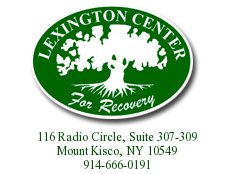 The applicant for this Special Use Permit, Lexington Center for Recovery, already runs such programs in Dutchess, Rockland, Sullivan and Westchester Counties. As LCR’s Ulster hub, the proposed Marbletown facility would import and serve opioid-abuse sufferers from across the county.
The applicant for this Special Use Permit, Lexington Center for Recovery, already runs such programs in Dutchess, Rockland, Sullivan and Westchester Counties. As LCR’s Ulster hub, the proposed Marbletown facility would import and serve opioid-abuse sufferers from across the county.
Marbletown itself (population 5658 in the 2020 census) does not have a statistically significant opioid-abusing demographic — unlike, say, the city of Kingston (population 24K in the 2020 census), half an hour away. Nonetheless, it seems only fair for Marbletown to take on this outsize share of the county’s social-services operations.
The proposed facility will dispense its clients’ prescribed dosages of methadone every morning (starting at 6 a.m.), 365 days per year, while also offering them periodic medical exams, counseling, and other assistance. Nestled in a wooded cul-de-sac, invisible from the highway, it will not in itself intrude on the outward appearance of the town. It will only impact the three private residences on Lamberti Lane, just 200 feet away from the Gagnon Drive building and in full view thereof. Weighed on the larger scale of things, its predictable effect on those homeowners’ property values and sense of security is negligible, and the sacrifices involved on their parts mere fulfillment of their citizenly obligations to the town.
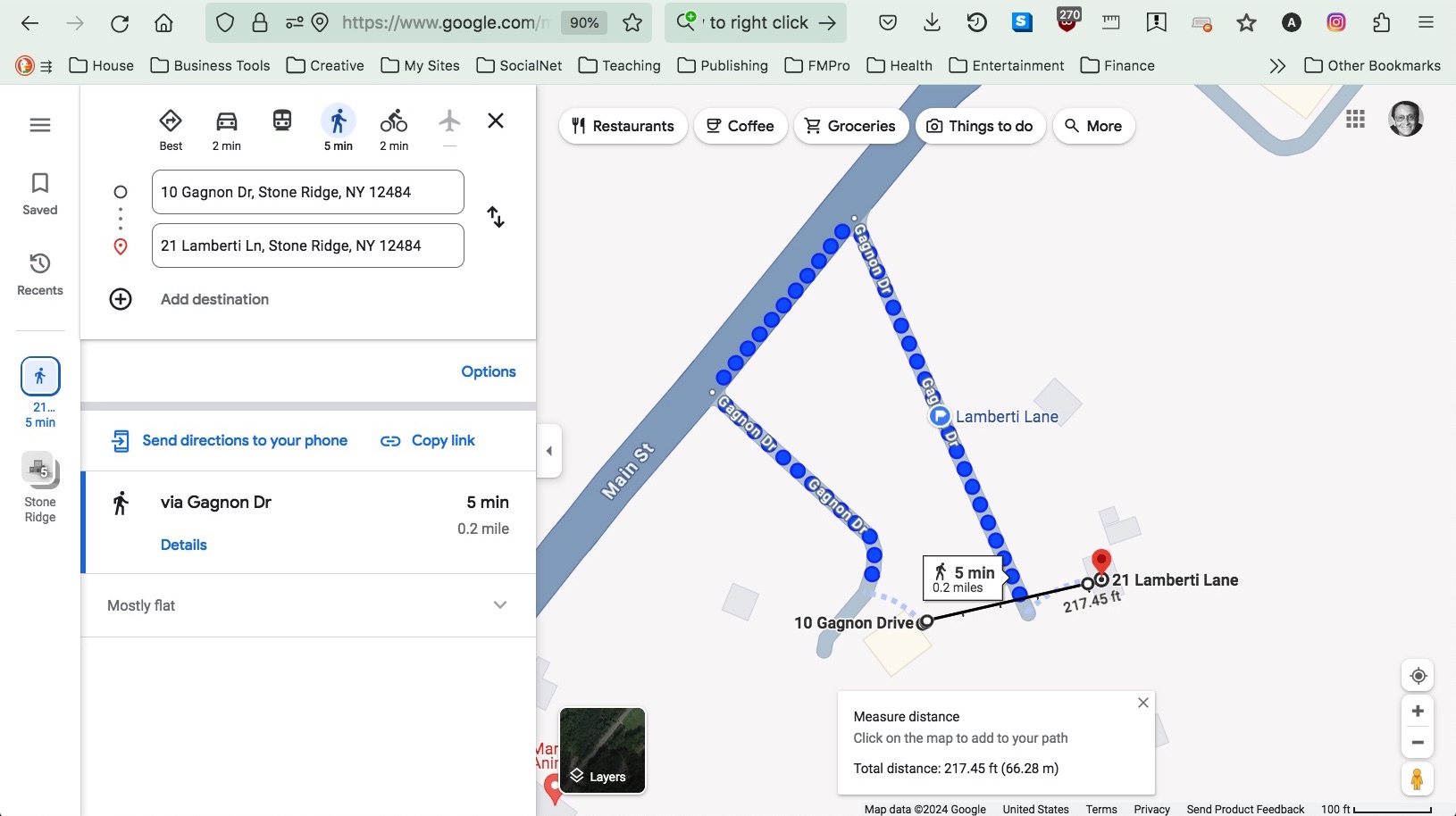
Google Maps, distance from 21 Lamberti Lane to 10-14 Gagnon Drive, screenshot
•
Transportation for this anticipated cohort of what we might call opioid tourists raises some obvious questions. Driving on methadone is often ill-advised, especially early on in treatment as dosages get adjusted and the client gets used to the effects. Some of our new guests, therefore, will presumably arrive via the UCAT bus system, the nearest stop for which is in front of the MyTown Marketplace mini-mall. Others will come by car, but will wisely opt not to drive while “under the influence,” and will therefore stay around until their dosage responses are under control. We can safely assume that only a small percentage of them will take to Main Street in their vehicles with their senses impaired.
Of course the proposed treatment facility can’t provide such amenities as full food service. Yet its clients will need food and drink, and a place to hang out. Fortunately, the aforementioned MyTown Marketplace can serve that purpose admirably. Conveniently, it lies a mere half-mile walk from Gagnon Drive, along a stretch of 209 that has no sidewalks. However, if you tread carefully the heavy northbound morning traffic poses no safety risks, and you eventually get used to the noise and rush of those cars and trucks.
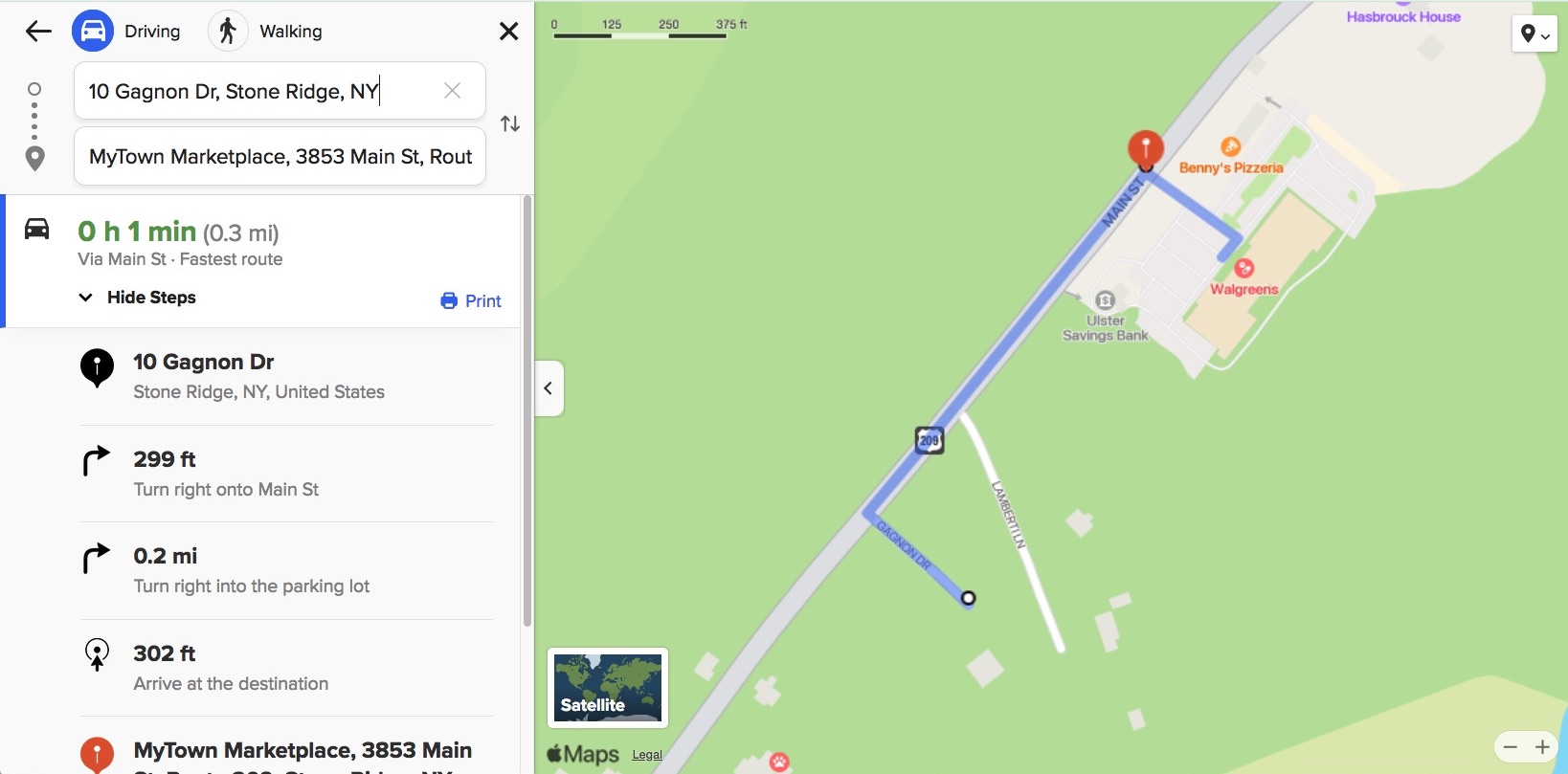
Google Maps, distance from 10-14 Gagnon Drive to MyTown Marketplace, screenshot
•
Once the facility’s clients reach the mini-mall they will find a wide range of choices for food and beverages, both alcoholic and non. There’s the excellent MyTown Marketplace supermarket, but also Ming Moon (Chinese), Benny’s Pizzeria (Italian), and Dunkin’ Donuts. Not to mention Stone Ridge Liquors, Walgreen’s drugstore, and even Shangri-La Hair Salon. Imagine the bustle once these newcomers show up! What local business would not welcome an influx of new year-round customers?
Unfortunately, only Benny’s and Dunkin’ have seats, and not very many at that. Presently, any customers beyond their capacity would have to shelter outside under the overhangs, uncomfortable once the weather gets cold. Perhaps, once Ulster Savings Bank vacates its current branch office and moves south to its new location, the present USB building can get repurposed as a year-round clubhouse of sorts for these visitors.
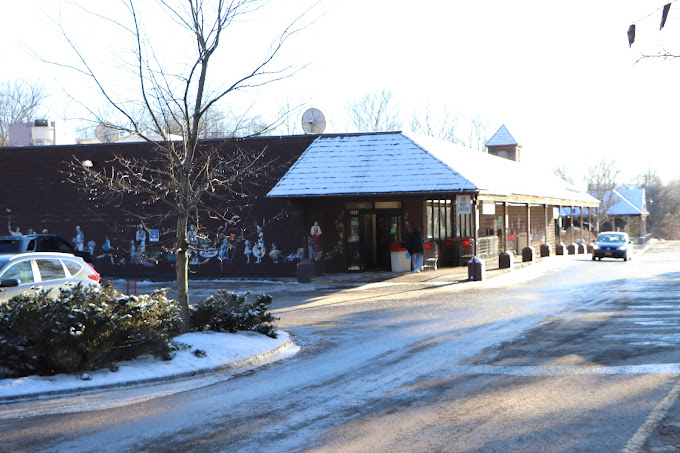
MyTown Marketplace
However, the MyTown Marketplace complex has ample grounds fronting on 209. So, when the weather warms up, LCR clients can lounge in the shade of the trees, sunbathe on the open lawns, picnic around USB, and otherwise showcase the casual, convivial atmosphere that makes Marbletown what it is. (Possible roadside signage: Marbletown — come for the opioids, stay for the ambience!)
And if they need a restroom, Dunkin’ Donuts can accommodate them. Plus there are woods alongside and behind the mini-mall that can absorb any overflow.
Needless to say, all of this depends on the decision of the Planning Board of the Town of Marbletown, which has final say in the matter. We can have confidence that they’ll take their guidance from the unofficial motto of the Parete administration: What’s good for business is good for Marbletown!
/s/ Allan D. Coleman
Cui Bono?
It should come as no surprise that local commercial interests have the government of the Town of Marbletown in their pocket. That’s commonplace in governments everywhere in the U.S., from small-town to megalopolis.
 So I did not attend the Planning Board’s “Open Hearing” of the methadone clinic proposal with any expectation that our concerns would have any effect on the outcome. By the time this Planning Board opens any proposal for public discussion, that project has already received the Board’s stamp of approval and entered the pipeline. The hearing, a mere formality, functions as a platform for the town government to tell its constituents what it intends to do, to field any questions, and to take note of any concerns for the purpose of papering them over.
So I did not attend the Planning Board’s “Open Hearing” of the methadone clinic proposal with any expectation that our concerns would have any effect on the outcome. By the time this Planning Board opens any proposal for public discussion, that project has already received the Board’s stamp of approval and entered the pipeline. The hearing, a mere formality, functions as a platform for the town government to tell its constituents what it intends to do, to field any questions, and to take note of any concerns for the purpose of papering them over.
Toward that end, the town government offers to those making any business-related proposal free private sessions to assist them in fine-tuning their proposals for Board approval. Effectively, they groom applicants for success. They offer no such advisory sessions to those who oppose any proposal, leaving them to fend for themselves and giving them short shrift at the hearings.
To put it bluntly, this was a done deal before the meeting opened. Consider the following as evidence:
- The town government issued no press release announcing this significant proposal. Notice of this hearing, couched in bureaucratese, was “posted” in one regional newspaper, at the town government’s website, and physically on the town government’s bulletin board.
- Direct notice by mail of the proposal and the hearing got sent only to the 23 homeowners and businesses within 500 feet of the proposed clinic.
- Review of the proposal prior to the hearing required a pre-scheduled, in-person visit to the government offices.
- The Planning Board set up no situation for actual, open and open-ended public debate of this proposal. They allotted merely an hour for all synopsis of the proposal and commentary thereon at the start of a monthly Planning Board session with other items on the agenda.
- Clearly as a result of the off-the-record grooming session, proponents of the clinic packed the hearing. These included the founder of this chain of methadone clinics, the current director of the chain, a former director thereof, current and former employees of the clinic, etc. — roughly a dozen advocates, mostly management and employees, none of whom, as it happens live in Marbletown, and none of whom will live next door to or even near the facility.
- Inevitably, the comments of all these well-meaning caregivers outweighed the skeptics, who — due in part to the deliberately under-publicized issues at stake — included only myself and a local paramedic, each of us allotted a mere three-and-a-half minutes to make our cases.
- Given the minimal publicity for this venture generated by the town government, the lack of response from the citizenry to a plan that commonly generates controversy and opposition hardly comes as surprise. That’s how the Planning Board wanted it. The fact that (save for my letter) the local press ignored it completely surely contributed to that situation.
These facts suggest that the fix is now, and has always been, in.
•
Planning Board Chair Max Stratton made a point of prefacing my brief comments with an indication that he took umbrage at my suggestion that making money had anything to do with this Board’s endorsement of the clinic. Nonetheless, he proved unable to answer my basic question: How does Marbletown benefit from the establishment of this clinic in this location?
That’s a version of the classic premise for criminal investigation: Cui bono? Who profits? Sometimes paraphrased as “Follow the money.” Let’s set aside my snark about sales at the local mini-mall, whose impact on the town’s economy will prove negligible, and use this tool.
 The management and staff of the methadone clinic — none of them local residents or taxpayers — will benefit. Few if any of them will live here or pay local taxes. Average pay in New York State for a methadone RN (registered nurse) lies between $60-65K per year. Related MD and administrative salaries go much higher.
The management and staff of the methadone clinic — none of them local residents or taxpayers — will benefit. Few if any of them will live here or pay local taxes. Average pay in New York State for a methadone RN (registered nurse) lies between $60-65K per year. Related MD and administrative salaries go much higher.
However, the greatest profit will surely accrue to the owner of the building that will serve as the clinic’s facility: Off the Orchard LLC, located in Milton, NY, 100 miles away. So its principals won’t live near this clinic either.
Formerly the home of a family medicine practice, then home base for HowGood, “a SaaS data platform with the world’s largest database on food and personal care product sustainability,” this commercial structure has features specially designed to serve a medical/scientific operation. Which of course delimits its market considerably. Contracting long-term with the methadone clinic will give this difficult-to-rent property’s owners a government-guaranteed annual income for the foreseeable future.
There’s another potential site in the town, just a few hundred yards away heading south: a one-story commercial complex at the junction of Route 213 and 209, immediately adjacent to fewer residences, and vacant save for a small emergency pet clinic. With an ample parking lot and entrances from both roads. In terms of impact on the town and property values, much better in every way (though not already set up for medical use). I have not managed to find out whether this was even considered, and, if so, rejected for reasons unknown.
•
Chairperson Stratton claimed to have gathered research indicating that such facilities have negligible effect on real-estate prices, which would contradict what I’ve found here and here. As one commenter notes,
“Adjacent property values suffer and disclosure is required of sellers. These facilities remain best located in office and commercial locations compatible with medical offices and facilities, not in residential neighborhoods.”
He also had no information on how the presence of this clinic would affect the local crime rate, though he promised to present that at the Board’s next meeting in late March.
In the event, if this goes through — and I don’t doubt that it will — Anna and I will have moved out of a community where we got to watch drug abuse (and the presence of a nearby methadone clinic in response thereto) leave a promising community frozen in social, cultural, and economic stasis, only to have a front-row seat as another methadone clinic even closer to us impacts an even smaller, and more isolated community. Reports to follow, as they say.
•
This post supported in part by a donation from Carlyle T.
•

Special offer: If you want me to either continue pursuing a particular subject or give you a break and (for one post) write on a topic — my choice — other than the current main story, make a donation of $50 via the PayPal widget below, indicating your preference in a note accompanying your donation. I’ll credit you as that new post’s sponsor, and link to a website of your choosing.
And, as a bonus, I’ll send you a signed copy of my new book, poetic license / poetic justice — published under my full name, Allan Douglass Coleman, which I use for my creative writing.


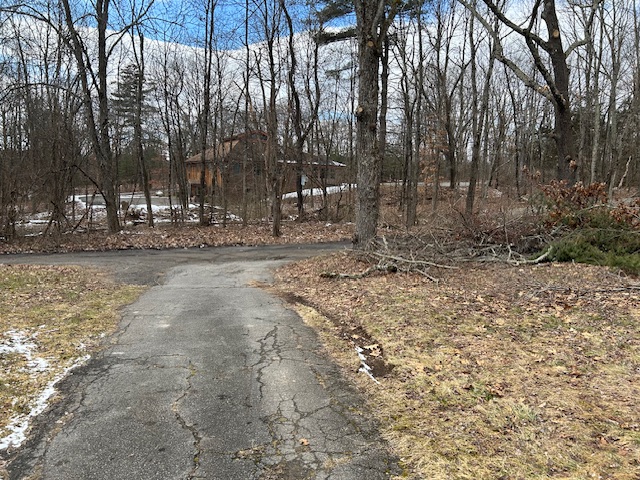




Dear Allan,
I sincerely hope that you and your neighbors can overcome this problem. By Neighbors I mean more than the 23 that are within 500 feet of the proposed clinic. As you called them, these new “tourists” will be moving about the commercial section of Stone Ridge and have some kind of impact that affects the quality of life of many more than the 23. Can you organize? Is there money to hire a lawyer to represent such a group before the Planning board? I await your future posts on this matter. I know how quality of life can change in rural areas.
Harry
Per my post, the Planning Board has so far — deliberately, in my opinion — kept this proposal for a methadone clinic under the radar. I’m the only resident to have raised any objection, to the best of my knowledge, and I’m not sure how many people even know that it’s on the table.
We ourselves have no money for a lawyer. As for organizing a protest, at 80 I don’t have the energy for door-to-door canvassing. Best I can do is raise the alarm in the press and hope that it alerts others to the situation.